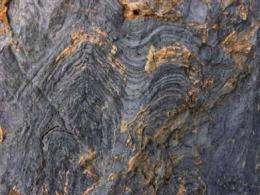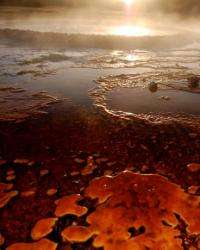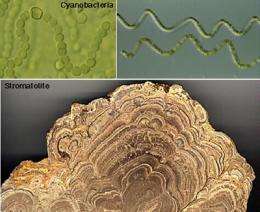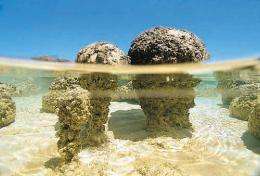Stepping stones through time

Stromatolites are the most ancient fossils on Earth, and these structures built by microbes can still be found forming today in various places around the globe. Although they provide a straight line of life’s history from the past to the present, comparing modern and ancient stromatolites is not a straight-forward endeavor.
Visit a natural history museum, and you will see ancient rocks bearing the imprints of leaves, shells, fishes, and other shapes of life. The oldest life in the fossil record, however, is not so easily identified at first glance.
Called “stromatolites,” these fossilized layers associated with microbial biofilms or mats date back to nearly 3.5 billion years ago. While the microbes that formed the mats generally are not preserved, the wrinkled striped patterns in the rocks suggest life was once there.
The understated appearance of stromatolites belies their major importance in the history of life on Earth. Stromatolites are the most ancient fossils, and therefore might provide clues to how life evolved from very simple to more complex forms. Stromatolites are Earth’s most enduring biological communities – while other species have risen and fallen over the course of history, stromatolite communities have persisted through time and still are found today in various locations around the globe. Ancient stromatolites can help reveal details about the early Earth’s environment. Their formation likely altered the environment as well, leading to the accumulation of breathable oxygen and the evolution of multi-cellular life (including humans). It is no exaggeration to say that life today stands on a deep and firm foundation created by stromatolites.
The House that Life Built?
To understand how stromatolites shaped the world, it helps to know how they are made.
Stromatolitic microbes – mostly bacteria and archaea -- live in a wafer-thin biofilm or mat that is bound together by mucus and other sticky substances the microbes produce. In most modern stromatolites, cyanobacteria or other photosynthetic organisms live at the surface of the mat and generate oxygen as they obtain food using sunlight and carbon dioxide, while the oxygen-free lower regions are often populated by microbes that consume methane or sulfate.
Modern-day stromatolites are found in shallow bodies of water, and when silt and other elements in the environment fall into the sticky mat, the photosynthetic microbes migrate upwards, slowly building a fresh new mat on top of the old. In doing so, they leave behind not only the environmental debris, but also carbonate or silica formed from the chemical environment within the stromatolites. This complicated conglomeration is what ends up being preserved in old rocks.
Scientists are working to tease out what features in the layers are the direct results of biology. One clue is in the chemistry. For instance, micro-organisms ingest the carbon-12 isotope faster than carbon-13, so when the carbonate in a stromatolite is rich in C-12, it was probably made by life.
This is an important distinction, because stromatolite-like structures can form without biology. In that case, the layers are made from sediment deposition in carbonate-or silica-rich lakes or oceans, or through the periodic eruption of minerals from hydrothermal vents.
David Des Marais of NASA’s Ames Research Center says that any habitable planetary environment potentially can create geological features which mimic life.
“There’s going to be a lot of ambiguous examples, because many of the processes that would give rise to features that mimic life are the same kinds of processes that would support life,” he says. “That’s the nature of Nature.”

Des Marais says stromatolites represent a central challenge in astrobiology: understanding the “signal-to-noise”, or the biological versus abiological relationships of features observed in habitable environments. How do you pick out life’s fingerprint from a planet’s basic geology and chemistry?
The delicate biological material of single-celled microbes doesn’t last over the eons, and the older rocks are, the more alteration they’ve undergone -- either through erosion above the ground or by exposure to different temperatures and pressures below it. Stromatolites are like pages in Earth’s history book that describe the interplay between biology, chemistry, and geology, but the writing is often blurred, indistinct, or indecipherable.
To read between the lines, scientists are closely analyzing the fossil remnants and comparing them to the few stromatolite communities that exist today in places such as Lagoa Salgada, Brazil, Cuatro Ciénegas, Mexico, and Pavilion Lake in Canada. Every modern stromatolite population is a potential key for unlocking the secrets of the past.
Sampling Stromatolites
Modern stromatolites were first discovered growing in the salty waters of Shark Bay, Australia in 1956. Dominic Papineau of the Carnegie Institution in Washington says that while the Shark Bay stromatolites are structurally similar to the ancient fossils, shape alone can’t tell you much because the environment of early Earth was so different. For instance, modern stromatolites often contain foraminifera, tiny life forms that weren’t around when the more ancient stromatolites formed. The introduction of any new material will inevitably change the overall shape of a stromatolite.
“Clearly formaminifera are much younger types of biomineralizing microorganisms than those that we expect from Precambrian and especially Archaean stromatolites,” he says.
Papineau found that the Shark Bay stromatolites have a complex community of 19 lineages of identifiable bacteria, as well as many archaea. A big surprise, however, was the minority status of cyanobacteria. Usually a dominant microbe in stromatolites, the Shark Bay cyanobacteria made up only five percent of the bacterial population in the samples he analyzed.

Cyanobacteria are so prevalent in modern stromatolites that scientists often refer to them in the same breath. These photosynthetic bacteria are thought to play a vital role in the mat, producing the fuel needed by the other microbes. It is not known how far back in time this relationship goes -- cyanobacteria probably evolved at least 2.4 billion years ago, but the exact date of their origin is a topic of great controversy.
“Because cyanobacteria are such a small part of [the Shark Bay] community, a geological implication is that there might have been stromatolites that were built by organisms that did not include cyanobacteria,” Papineau says.
Cyanobacteria are completely absent in certain stromatolites that exist today in the acidic pools of Yellowstone National Park. David Ward of Montana State University has been studying these modern stromatolites that instead have photosynthetic microbes which don’t produce oxygen.
Ward and his colleagues are trying to determine if different microbial communities build different types of stromatolites. This could tell scientists a great deal about what sort of microbes may have built the ancient stromatolites in the fossil record.
Ward points out, however, that the extreme environments of the Yellowstone pools are very different from the coastal regions where ancient stromatolites tended to form. Once again, environmental differences complicate analogies between the past and present stromatolites, but Ward says scientists still can learn about the number and variety of species involved, and how those species interact.
“If you compare the general types of microbes found in different kinds of extreme environments today, there are many similarities – for example, similar kinds of functional guilds, or similar patterns of function,” he says. “These give us insight into how the ancient communities may have been organized.”

A Change of Scene
Studies of modern stromatolites have shown they are not uniform across the globe – not only do they have different shapes, but each host a wide and unique range of bacteria and archaea. Stromatolite mats also can contain viruses and eukaryotes – organisms that have their DNA contained within a nucleus (all multi-cellular life on Earth is eukaryotic). Scientists even have found that microbial mats sometimes don’t produce the typical fine layering, but instead form a round ball or lumpy mass. These non-layered formations are given the more general name “microbialite.”
It’s tempting to think the variations in modern stromatolites could represent different stages in their evolution through time. The Yellowstone version could represent a more primitive type, and the Shark Bay version a slightly more advanced form.
However, Papineau says the modern stromatolite populations probably have adapted to the different environmental conditions in which they now live. Rather than reflecting earlier eras, the differences among them could simply be due to the unique biology, geology and chemistry that currently exist in these far-flung locations.
According to Des Marais, however, some environments today are similar enough to early conditions that the stromatolites may as well be living in the past. He points to stromatolites growing on the coast of Baja, Mexico as an example. At night, the cyanobacteria in the microbial mats stop producing oxygen and instead survive by fermentation.
“Inside the mat they are experiencing the same conditions today that they probably experienced 1 to 2 billion years ago,” says Des Marais. “At any one time in geologic history, there’s a lot of different environments around, and probably what’s changed more than anything else is the relative distribution and abundance of them.”
Some of the most ancient stromatolite fossils yet found, in the 3.35-billion-year-old Strelley Pool chert of Western Australia, were part of a fossilized ocean reef. Seven different types were identified, so there was already a variety of stromatolite shapes even back then. It’s not known what kind of microbes made them, although most scientists who study stromatolites at least agree that the Strelley Pool stromatolites are biological.
Des Marais says that thanks to new micro-analytical techniques, scientists will continue to make progress on learning about the history of stromatolites on Earth.
“Like Kennedy said, we do this not because it’s easy,” he notes. “Of course, [we also do it because] it’s a significant issue and we really want to get these answers.”
Source: Astrobio.net





















